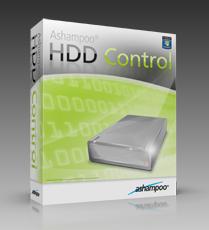Ashampoo HDD Control
As long as the drive is functioning properly, you are lulled into a false sense of security. However, when the trusted hard drive suddenly fails, this is more than just a minor inconvenience. As a consequence, the data that is lost is often very damaging. Ashampoo HDD Control is therefore ideally suited to boost the performance of your drive, guard against disk failure and remove clutter from your hard drives, while performing all three functions of monitoring, maintenance and defragmentation.
Monitoring: The software supports all commonly available IDE and serial ATA drives. Devices connected to the system via USB, firewire or RAID controller often do not support this function. Based on the type of drive in use, Ashampoo provides the user with all important facts and information, including the firmware version, cache size, number of configured partitions, drive space and current temperature. In the final report, the program also provides information on the health and performance of the hard drive.
Maintenance: Over time, an ever-growing number of unwanted and unneeded files accumulate on your hard drive and Ashampoo HDD Control is a useful tool to help you locate and delete these files. Temporary files, files in the recycling bin and backup copies are all removed. In addition, the software empties the cache, clears the browsing history and erases cookies from the Internet browser.
Defragmentation: With its defrag module, the program is able to read out file fragments and arrange these in one cluster on the hard drive to ensure rapid access. As a result, the hard drive needs to spin less while the performance remains unchanged. As an additional benefit, there is less demand placed on system resources. Proactive defragmentation uses the time when you are not working to measure the level of disk fragmentation. If it needs to be defragmented, the process is started automatically.
Features of Ashampoo HDD Control
Basic functions:
- Information on serial numbers, firmware, cache, bad sectors on your hard disk(s)
- Background guard continuously monitors status, performance and temperature
- In-depth explanations and information on context-sensitive help
- Displays all current SMART files with detailed explanations
- Able to export reports for support purposes
- Fully configurable temperature monitoring available in Celsius and Fahrenheit
- Option to automatically save all incidents in separate log
- Simple controls and GUI including color schemes
- Easy and automatic software updates
- Powerful, high-speed disk clean-up
- Objects found can be configured and managed in shortcut menus
- Objects found can be managed using intelligent filter mechanisms
- New exception rules can be created manually or automatically
- Supports the latest generation of browsers (Firefox, Internet Explorer, Opera)
- Wide range of options to customize configuration to meet user requirements
- High level of security thanks to years of experience and advanced cookie management
- High-quality defragmentation performed to latest standards
- Fully automatic ‘proactive’ defragmentation runs in background
- Defragmentation algorithm with minimum impact on system performance
- Range of defragmentation options (fast, normal, intelligent)
- Parallel defragmentation of all drives and/or partitions
- Comprehensive configuration and customization options
- Self-monitoring, analysis, status reports on imminent failures
- Evaluation of health and performance status of your hard drive(s)
- Range of evaluation criteria available for customized configuration
- Email alerts to notify user that condition of hard drive(s) has deteriorated and failure is imminent
- Direct link to Windows event log
- S.M.A.R.T. technology provides information on (if supported by drive):
- Number of hours in operation and start-up processes
- Error rate during positioning
- Start/stop processes of drive heads
- Number of parking sequences for write/read units
- Disk calibration attempts
- Reallocations (in event of bad disk sectors)
- Controller hard drive transfer rate (defective cable)
- Temperature display including early warning of overheating









0 comments:
Post a Comment